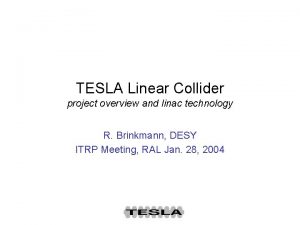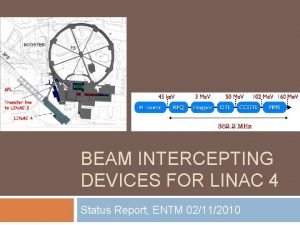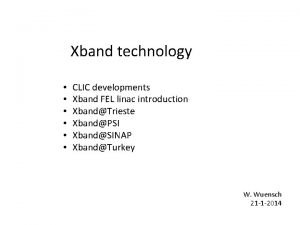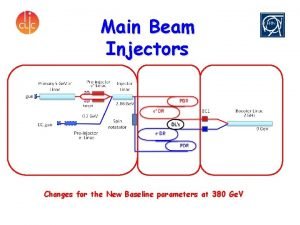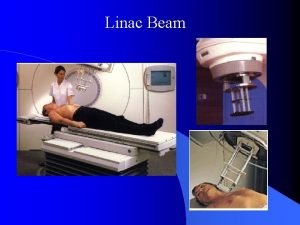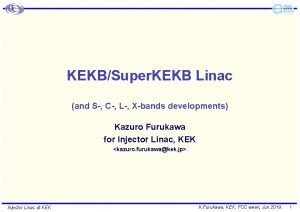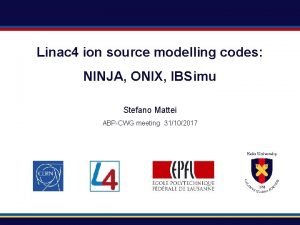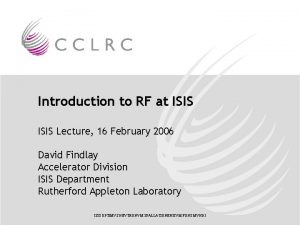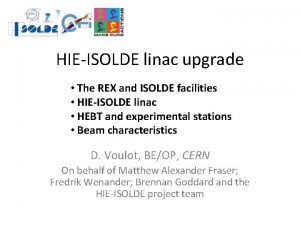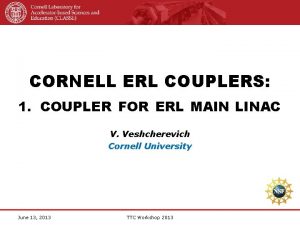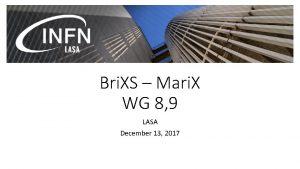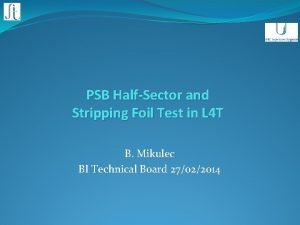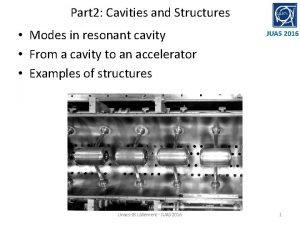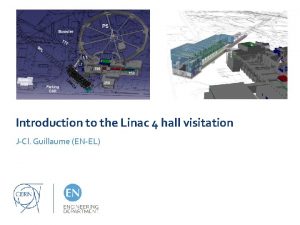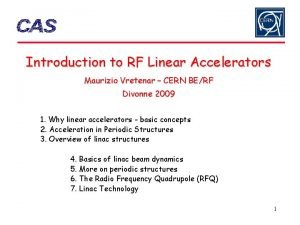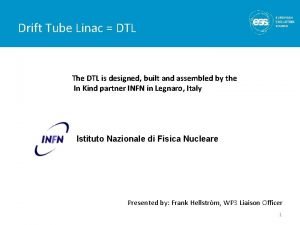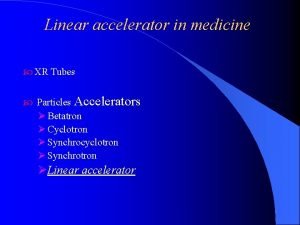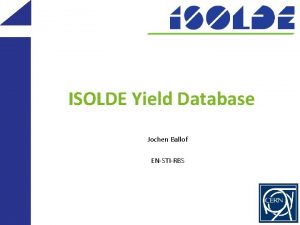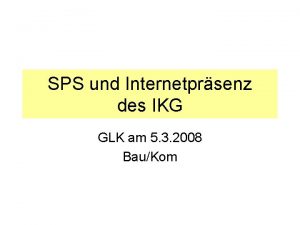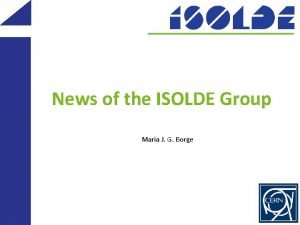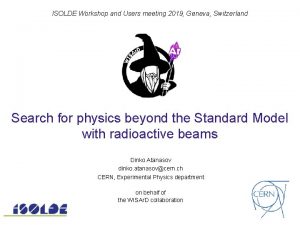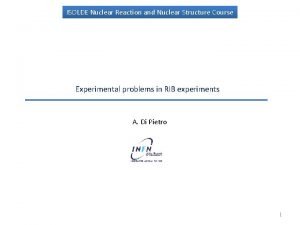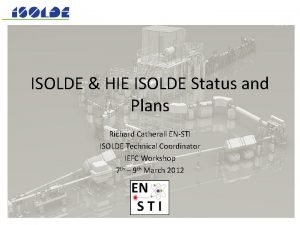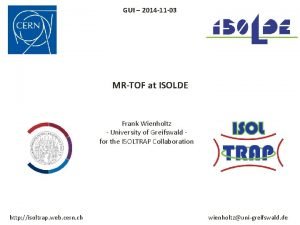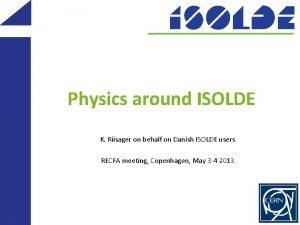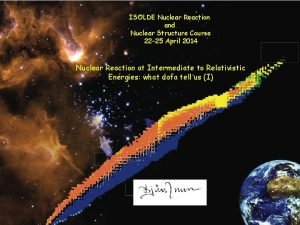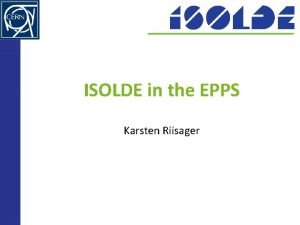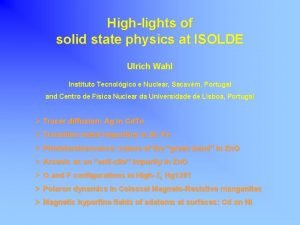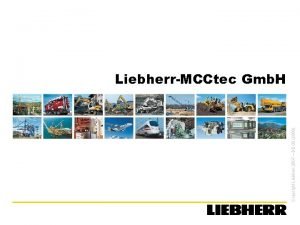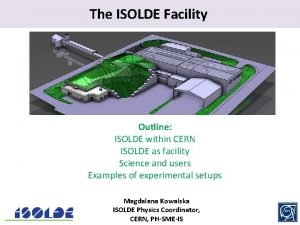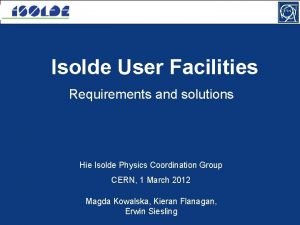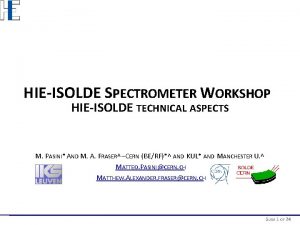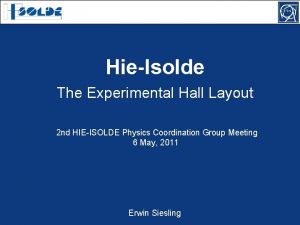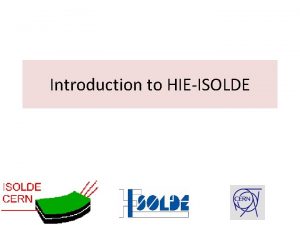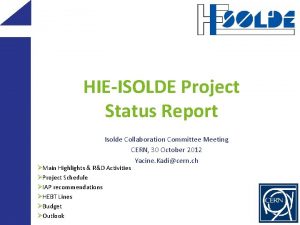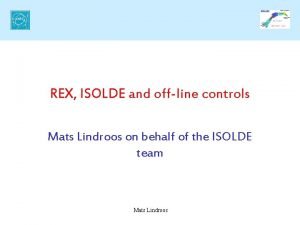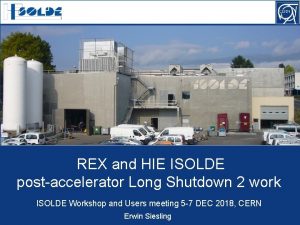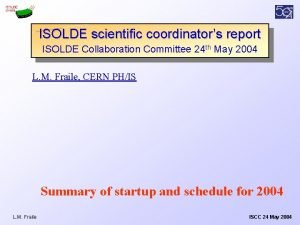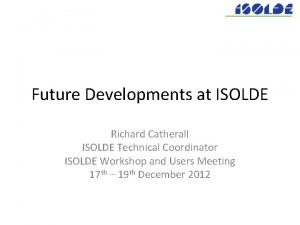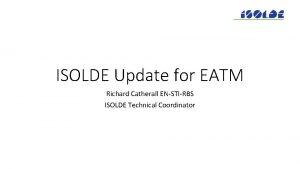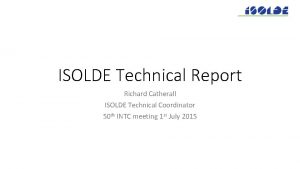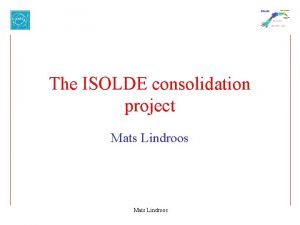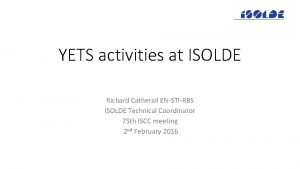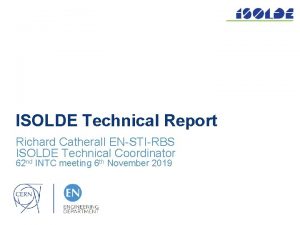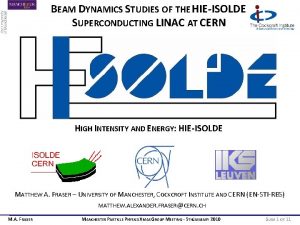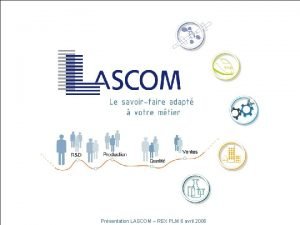HIEISOLDE linac upgrade The REX and ISOLDE facilities






























- Slides: 30

HIE-ISOLDE linac upgrade • The REX and ISOLDE facilities • HIE-ISOLDE linac • HEBT and experimental stations • Beam characteristics D. Voulot, BE/OP, CERN On behalf of Matthew Alexander Fraser; Fredrik Wenander; Brennan Goddard and the HIE-ISOLDE project team

ISOLDE overview

REX-Isolde overview * charge breeding * 1+ ions to n+ REXEBIS MASS SEPARATOR Optional stripper 9 -GAP RESONATOR Experiments 3. 0 Me. V/u 7 -GAP RESONATORS 2. 2 Me. V/u * 6 cavities * 300 ke. V/u to 3 Me. V/u IH 1. 2 Me. V/u Rebuncher RFQ 0. 3 Me. V/u REXTRAP 60 ke. V ISOLDE beam * longitudinal accumulation and bunching * transverse phase space cooling

REX linac 5 ke. V/u RFQ 300 ke. V/u IHS 7 GP 1. 2 Me. V/u 9 GP 2. 2 Me. V/u 3 m Linac: Length Freq. Duty cycle Energy A/q Trans. 11 m 101 MHz (202 MHz for the 9 GP) 1 ms 100 Hz (10%) max. 3 Me. V/u 2. 0 - 4. 5 90% (lower for highly charged beams)


ISOLDE Statistics 2011 ISOLDE Shifts (8 h): Scheduled: 471. 5 Delivered: 329. 5 (+134 for machine development and test) REX-ISOLDE: 147 (45%)

HIE-ISOLDE A general upgrade of ISOLDE: High Intensity and Energy – High intensity: upgrade of target area, separators and charge breeder (design study) – High energy: HIE-LINAC • • R&D activities for the linac (started in 2008) Approved CERN project 2010 5. 5 Me. V/u (stage 1) 2015 / 10 Me. V/u (stage 2) 2016 -2018 36. 5 MCHF, 50% financed through external collaboration 7

Motivations Superconducting linac => “array of small independent resonating cavities, equipped with their own small RF amplifier “ -> No high power amplifier (< 10 W of RF diss. In the cavity) -> High accelerating gradient (6 MV/m) -> Short + independent cavities = high flexibility -> CW operation 8

SC quarter-wave cavities Low b f (MHz) 101. 28 b 0 6. 3% 10. 3% Gradient Ea (MV/m) 6 6 Inner Cond. Diam (mm) 50 90 Outer Cond Diam (mm) 195 300 Mechanical Length (mm) 215 320 Gap length (mm) 50 85 Beam Apert. Diam. (mm) 20 20 Rsh/Q (Ohm) 564 548 Q 0 min for 6 MV/m at 7 W 3. 2 108 5 108 TTF max 0. 85 0. 9 No. of cavities 12 20 Highb 9

HIE High-beta Cryomodule QWR Vacuum vessel Liq. He reservoir Supporting frame Beam Focusing solenoid Tuning plates 10

HIE linac (Stage 2 b) 16 m 12 low-beta cavities 20 high-beta cavities 39. 6 MV accelerating voltage 11

0. 3 Me. V/u Energy RANGE: STAGE 1 1. 2 Me. V/u 2. 25 Me. V/u 2. 8 - 3. 0 Me. V/u A/q = 2. 5 W = 8. 8 Me. V/u βγ = 0. 136 A/q = 2. 5 W = 3. 0 Me. V/u βγ = 0. 080 A/q =4. 5 W = 2. 8 Me. V/u βγ = 0. 0773 A/q =4. 5 W = 5. 5 Me. V/u βγ = 0. 109

0. 3 Me. V/u Energy RANGE: STAGE 2 a 1. 2 Me. V/u 2. 25 Me. V/u 2. 8 - 3. 0 Me. V/u A/q = 2. 5 W = 14. 5 Me. V/u βγ = 0. 177 A/q =4. 5 W = 9. 3 Me. V/u βγ = 0. 140 A/q = 2. 5 W = 3. 0 Me. V/u βγ = 0. 080 A/q =4. 5 W = 2. 8 Me. V/u βγ = 0. 0773

0. 3 Me. V/u 2. 5 < A/q < 4. 5 W = 1. 2 Me. V/u βγ = 0. 051 Energy RANGE: STAGE 2 b 1. 2 Me. V/u

0. 3 Me. V/u Energy RANGE: STAGE 2 b 1. 2 Me. V/u A/q = 4. 5 W = 16. 8 Me. V/u βγ = 0. 187 A/q = 4. 5 W = 10. 2 Me. V/u βγ = 0. 147 Highest rigidity: W = 10 Me. V/u A/q = 4. 5 Bρ = 2 Tm 2. 5 < A/q < 4. 5 W = 1. 2 Me. V/u βγ = 0. 051

HIE-REX Cavity: Nb sputtered on Cu 16

Beam characteristics Characteristic Value (for A/q = 4. 5) Particle type Heavy (radioactive) ions (A < 238) Mass-to-charge state (A/q) acceptance 2. 5 < A/q < 4. 5 Transverse emittance (normalised) (mm. mrad) 0. 07 (rms) and 0. 3 (90%) Longitudinal emittance (π ns ke. V/u) 0. 35 (rms) and 1. 5 (86%) Energy (Me. V/u) 0. 3 – 10 Average Beam Current ~ few particle per sec – 1 n. A Maximum rigidity (T. m) 2. 05 Macro-pulse length (ms) <2 Repetition rate (Hz) < 50

REX time structure Protons from PSB RIBs released from ISOL target Accumulation/cooling/macro bunching (up to 100 Hz) Charge breeding Duty cycle of linac matched to charge breeder/ion source Micro-bunching of EBIS beam pulse by RFQ at 101. 28 MHz μ μ

Chopper-buncher Goal: increase natural bunch spacing from ~10 ns (101. 28 MHz) to ~100 ns for physics with TOF systems Multi-harmonic pre-buncher operating at f 0/10 to ‘squeeze’ several bunches in one Beam chopper (meandering line or sine-wave) pulsed in phase with the beam to remove particles from empty bunches

High Energy Transfer lines and experimental stations 20




HIE Schedule

TSR@ISOLDE • Heavy-Ion Storage Ring + HIEISOLDE – – TSR at MPIK Heidelberg No background No energy straggling Cold beam/Smaller beamsize Reduced dead time/CW beam • Approved by research board May 2012 • Aiming for start-up in 2015 as an experiment, integration as CERN facility towards 2018 Possible TSR installation

Spare slides

TYPE IV Diagnostic box Collimator slit Type 2 Silicon detector FC Scanning slit Stripping foils

Magnets – present designs

Slow extraction normal extraction, 14 N 4+, measured in front of linac • Bunched beam = high instantaneous rate -> dead time • Good signal to noise ratio Slow extraction, 108 Sn, measured at Miniball

6 He 8, 9, 11 Li 10, 11, 12 Be 10 C 17 F REX beam collection 2001 -2012 21, 24, 25, 26, 27, 28, 29, 30 Na 28, 29, 30, 31, 32 Mg 44 Ar 61, 62, 63 Mn 61, 62 Fe 66, 68 Ni 67, 68, 69, 70, 71, 73 Cu 72, 74, 76, 78, 80 Zn 70 Se 72, 88, 92, 94, 96 Kr 93, 95, 97, 99 Rb 96, 98 Sr 100, 102, 104, 122, 123, 124, 126, 128 Cd 108 In 106, 107, 108, 109, 110 Sn 138, 140, 142, 144 Xe 140, 142, 148 Ba 140 Nd 148 Pm 140, 142, 153 Sm 156 Eu 182, 184, 186, 188 Hg >100 radioactive isotopes of 31 elements 186, 188, 190, 192, 194, 196, 198 Pb 196, 198, 200, 202, 206 Po 202, 204, 208, 220, 221 Rn 224 Ra A selection of stable elements charge bred
 Linac
Linac Beam stopper linac
Beam stopper linac Linac
Linac Linac
Linac Linac treatment head
Linac treatment head Linac
Linac Linac
Linac Linac
Linac Linac
Linac Linac
Linac Linac
Linac Linac 4
Linac 4 Linac 4
Linac 4 Linac 4
Linac 4 Neltun
Neltun Linac 4
Linac 4 Linac 4
Linac 4 Klystron vs magnetron linac
Klystron vs magnetron linac Isolde yield database
Isolde yield database Isolde kurz gymnasium reutlingen
Isolde kurz gymnasium reutlingen Maria jg
Maria jg Isolde workshop
Isolde workshop Reaction structure
Reaction structure Isolde
Isolde Isolde frank
Isolde frank Isolde k
Isolde k Isolde martinson
Isolde martinson @isolde
@isolde Isolde reveal
Isolde reveal Offshorekrane / bohrinselkrane
Offshorekrane / bohrinselkrane In keeping equipment and facilities safe and sanitary
In keeping equipment and facilities safe and sanitary
